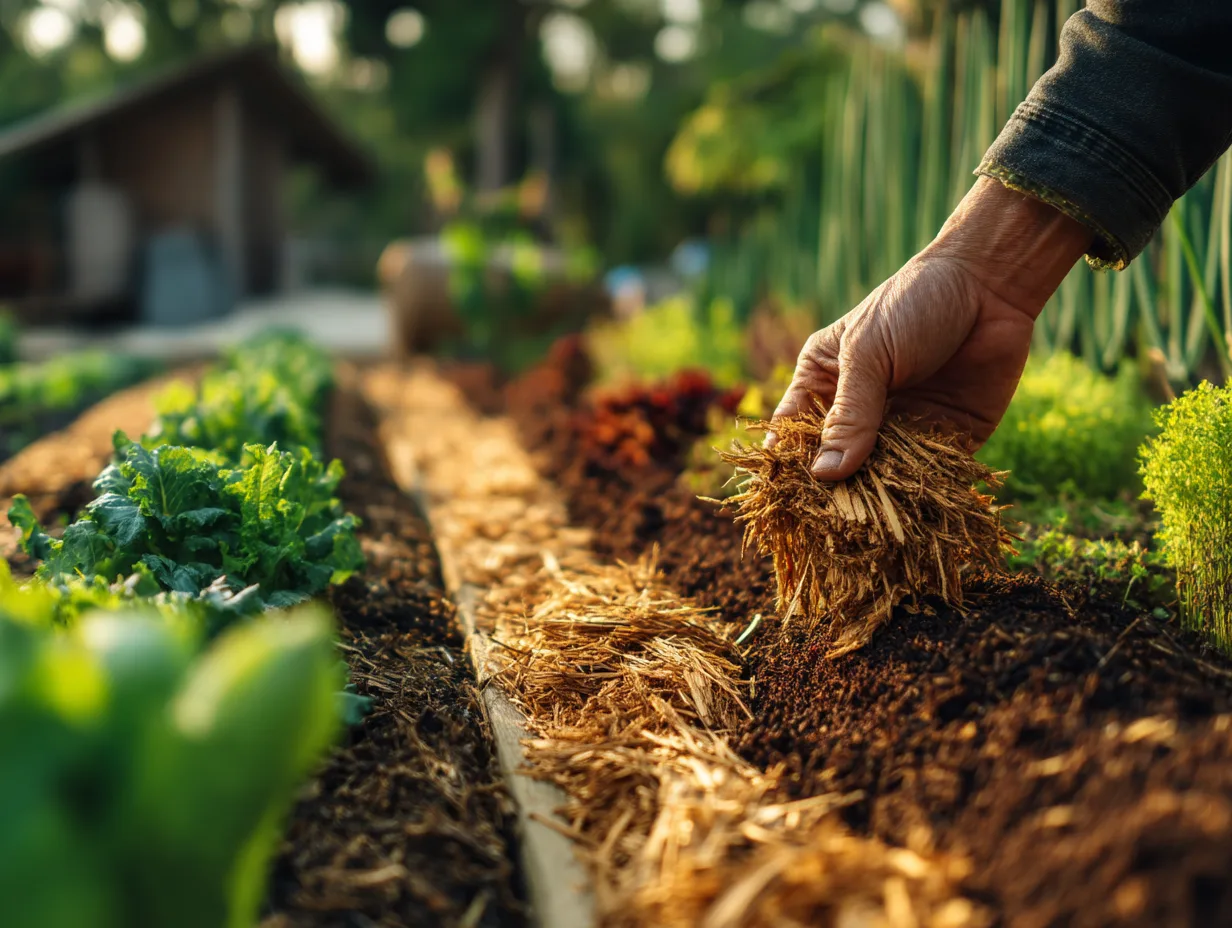No-Dig Gardening is an approach to soil health and productivity that has been gaining momentum among eco-conscious gardeners and farmers. Instead of relying on tilling or turning the soil—practices that can disrupt vital soil life—No-Dig Gardening centers on preserving the existing structure, microorganisms, and organic matter. This method uses layered compost, organic mulches, and strategic planting to create a thriving ecosystem. In this comprehensive guide, we’ll explore the philosophy behind No-Dig Gardening, its benefits, how to set up a no-dig plot, best practices for maintenance, and ways to overcome potential challenges. We’ll also refer to additional resources for deeper learning, including the wealth of knowledge in The Year-Round Vegetable Garden for Beginners.
Understanding the Philosophy of No-Dig Gardening
No-Dig Gardening, often associated with organic farming pioneer Charles Dowding, is rooted in the principle that soil is a living organism teeming with microorganisms, worms, and insects. These creatures facilitate nutrient cycling, improve soil structure, and enhance water retention. By disrupting these organisms through digging or tilling, gardeners risk releasing carbon stores, disturbing fungal networks, and damaging the structure that allows roots to penetrate and develop easily.
Why Avoid Tilling?
- Soil Structure Preservation: Tilling breaks up soil aggregates, which are crucial for aeration and root penetration.
- Moisture Retention: Undisturbed soil holds moisture better, reducing the need for frequent watering.
- Erosion Control: Loose, tilled soil can wash away more easily, especially during heavy rains.
- Carbon Sequestration: By not turning the soil, carbon remains locked in the ground.
For more tips on mindful water usage, see Efficient Watering Techniques for Sustainable Vegetable Gardening.
Key Benefits of No-Dig Gardening
When practiced correctly, No-Dig Gardening offers several advantages:
- Reduced Labor: Less time spent tilling, weeding, and amending the soil manually.
- Healthier Soil Biology: Microbes and worms thrive in stable conditions.
- Fewer Weeds: Thick layers of organic mulch suppress weed growth.
- Soil Fertility: Over time, layered compost naturally enriches the soil, negating the need for synthetic fertilizers.
- Water Efficiency: Intact soil structure and organic mulch help retain moisture, reducing irrigation needs.
These benefits align perfectly with the goals of sustainable agriculture and organic gardening, making the no-dig approach an excellent choice for both small-scale and large-scale operations.
Setting Up a No-Dig Garden Plot
Creating a no-dig plot is straightforward. You can start with an existing garden bed or convert a lawn area. Follow these steps to set the foundation:
- Choose a Location: Look for a spot with adequate sunlight—at least 6 to 8 hours a day for most vegetables.
- Eliminate Existing Vegetation: Smother grass or weeds by covering them with cardboard or thick layers of newspaper. This barrier will decompose over time.
- Layer Organic Matter: Spread 4 to 6 inches of compost or well-rotted manure on top of the cardboard. Add layers of straw, leaves, or other organic materials.
- Top with Mulch: Apply a final layer of organic mulch, such as wood chips or straw, to help retain moisture and suppress weeds.
- Planting: Make holes in the mulch and compost layer, then place your transplants or seeds directly into the prepared bed.
For an in-depth look at composting, see Composting 101.
Best Practices for Maintaining a No-Dig Garden
Maintaining your no-dig garden requires a slightly different mindset from traditional tilling methods, but once you adapt, you’ll find it to be less labor-intensive. Here are some tips to keep your garden thriving:
- Mulch Regularly: Each season, add fresh layers of mulch to replenish organic matter and maintain weed control.
- Top-Dress with Compost: Rather than mixing compost into the soil, simply spread it on top. Earthworms and other soil organisms will incorporate it naturally.
- Rotate Crops: As in any garden, rotating plant families helps break pest and disease cycles. For further guidance, check out The Essential Guide to Crop Rotation.
- Avoid Compaction: Minimize foot traffic on the beds to keep the soil structure intact.
- Manage Weeds Early: If weeds do appear, pull them before they go to seed, disturbing the soil as little as possible.
Overcoming Common Challenges
No gardening method is without its hiccups. While No-Dig Gardening is generally low-maintenance, a few challenges can arise:
- Slug and Snail Damage: Mulch-rich environments can attract these pests. Implement barriers, handpick them at night, or introduce natural predators.
- Initial Weed Pressure: In new plots, persistent weeds may pop through the cardboard barrier. Spot-mulch or weed promptly.
- Soil Amendments for Specific Deficiencies: If a particular nutrient is lacking, top-dress with targeted organic amendments or use compost tea. For additional insights on soil health, read The Science of Soil.
- Patience with Soil Improvement: It may take a season or two for your no-dig bed to reach optimal fertility levels.
Integrating No-Dig Principles into Any Garden
No-Dig Gardening doesn’t need to be an all-or-nothing venture. You can apply these principles to raised beds, container gardens, or even traditional rows:
- Layering Organic Material: Wherever possible, avoid turning the soil; instead, add compost and mulch on top.
- Careful Use of Cover Crops: Some cover crops can be cut and left to decompose on the surface, further enriching the soil.
- Permanent Pathways: Define footpaths to reduce compaction in planting areas.
For eco-friendly pest solutions, consider our guide on Eco-Friendly Pest Control to maintain balance in your garden ecosystem.
No-Dig Gardening in Different Climates
The no-dig approach is adaptable to various climates, from temperate zones to arid regions:
- Arid Climates: Mulch-heavy systems retain moisture, making no-dig plots especially valuable in water-scarce environments.
- Cold Climates: The soil warms slower under heavy mulch, so consider starting seedlings indoors. Still, the retained moisture and nutrients pay off in the long run.
- Tropical Climates: Rapid organic decomposition may require more frequent mulch additions.
By tailoring your mulch thickness and compost choices, you can make the no-dig method work nearly anywhere.
Sustainability and No-Dig Gardening
No-Dig Gardening aligns with broader sustainability goals. It conserves water, reduces fossil fuel usage (no mechanical tillers needed), and fosters biodiversity in the soil.
Carbon Sequestration
Leaving soil undisturbed allows it to act as a carbon sink. Healthy, biologically active soils can lock carbon in the ground, helping to mitigate climate change.
Biodiversity
Microorganisms, earthworms, and beneficial insects thrive in no-dig systems, creating a mini-ecosystem that supports plant growth and natural pest control.
Local Food Production
By making gardening easier and more accessible, no-dig methods encourage local food production, cutting down on the transportation and packaging of produce.
Moving Forward with No-Dig
Adopting the no-dig system requires a shift in thinking. It challenges the idea that soil must be turned to remain fertile. Yet countless gardeners have found that this gentle approach leads to rich, productive gardens with fewer weeds, healthier plants, and vibrant soil life.
If you’re eager to learn more, don’t forget to explore The Year-Round Vegetable Garden for Beginners for advanced techniques and detailed case studies. Also, see Composting 101 for an in-depth look at producing top-quality compost to support your no-dig beds.


Leave a Reply